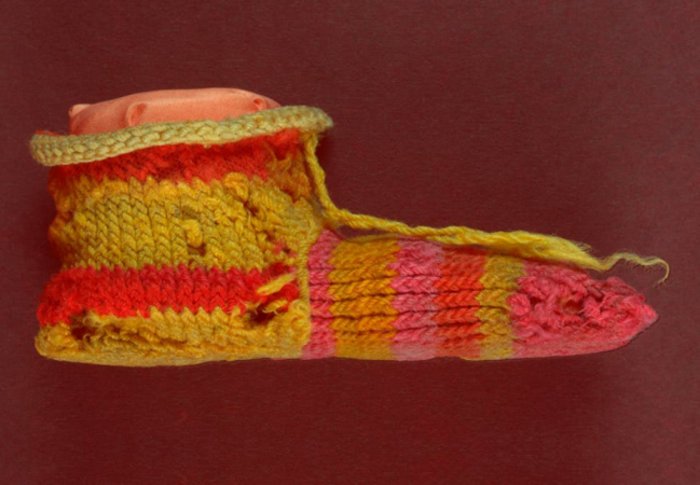Ancient Egyptians Used Stripy Socks And May Have Invented Them
Conny Waters – AncientPages.com - Socks have been around since the Stone Age when cave people used pelts or animal skins. However, ancient Egyptians were the first civilization to use knitted socks. Did they also invent stripy socks?
Ancient Egyptians were undoubtedly resourceful people and we owe them a lot. Not only did they invent the toothpaste, but they also had the first governmental health care system, and used door locks long before other civilizations, just to mention a few of their accomplishments.
Now it turns out that ancient Egyptians liked stripy socks. Whether they invented them is premature to say, but they were certainly one of the earliest civilizations that wore stripy socks.
Stripy child’s sock dating from 300AD was found in a rubbish dump in Egypt. Photograph: The British Museum
We know this because researchers at the British Museum have analyzed a sock that once belonged to an Egyptian child. The sock dates to about 300 A.D. and recovered from a rubbish dump in ancient Antinoupolis in Roman Egypt.
After such a long time it’s very difficult to see the sock’s original colors but using multispectral imaging scientists determined which dyes were used.
A combination of multispectral imaging and other techniques allow scientists to examine an artifact that is tiny and fragile without risking physically destroying a part of the object. We can see the past without destroying history so to speak.
The ancient Egyptian sock was once red, blue and yellow. Why a combination of these particular colors were chosen, is unknown. It could have been because the child’s parents simply liked the colors or maybe there is a symbolic meaning behind this color choice. We simply don’t know.
The subject of ancient Egyptian fashion was previously discussed on Ancient Pages, in our article Clothing And Jewelry In Ancient Egypt – How Did The Ancient Egyptians Dress? We know that “ancient Egyptians considered garments and cloth, one of the most important elements in a person’s life.”
Are you curious about how ancient Egyptians dressed? Find out here
“In ancient Egypt, clothing was an evident symbol of person’s social position and wealth. It was also used as a form of security for a loan or it was given away as a mark of respect and honor or left as legacy.”
Ancient Egyptians did not differ from other prehistoric civilizations. They liked colors and beautiful clothes, but there was a difference between how rich and poor dressed.
A 1,600-year-old Egyptian sock. Credit: V&A Museum
With this new multispectral imaging technology, scientists will be able to examine more textiles and we can get a better picture of the ancient world and learn how our ancestors dressed. We can also find out how important historical events affected their society.
Written by Conny Waters – AncientPages.com Staff Writer
Copyright © AncientPages.com All rights reserved. This material may not be published, broadcast, rewritten or redistributed in whole or part without the express written permission of AncientPages.com
Expand for referencesMore From Ancient Pages
-
 How Did People Go To The Toilet In The Past Before The Invention Of The Flush Toilet?
Archaeology | Jun 10, 2023
How Did People Go To The Toilet In The Past Before The Invention Of The Flush Toilet?
Archaeology | Jun 10, 2023 -
 Secrets Of Ninja Swords – Favorite Weapon Of The Shinobi
Featured Stories | Aug 13, 2018
Secrets Of Ninja Swords – Favorite Weapon Of The Shinobi
Featured Stories | Aug 13, 2018 -
 Lunar Society: Great Scientists Of The 18th Century Who Changed The World
Featured Stories | Jul 13, 2018
Lunar Society: Great Scientists Of The 18th Century Who Changed The World
Featured Stories | Jul 13, 2018 -
 First Animals On Earth Could Have Evolved Much Earlier Than The Oldest Fossils Suggest
Fossils | Oct 13, 2022
First Animals On Earth Could Have Evolved Much Earlier Than The Oldest Fossils Suggest
Fossils | Oct 13, 2022 -
 Kadıkalesi Castle Ancient Ruins: Female Skeleton Unearthed At An Archaeological Dig
Archaeology | Jan 9, 2023
Kadıkalesi Castle Ancient Ruins: Female Skeleton Unearthed At An Archaeological Dig
Archaeology | Jan 9, 2023 -
 Eugenio De Torralba – Renaissance Magician’s Dangerous Spirit Communications
Featured Stories | May 6, 2019
Eugenio De Torralba – Renaissance Magician’s Dangerous Spirit Communications
Featured Stories | May 6, 2019 -
 “Beowulf” – Old English Poem Was Probably Written By A Single Author – New Study
Archaeology | Apr 17, 2019
“Beowulf” – Old English Poem Was Probably Written By A Single Author – New Study
Archaeology | Apr 17, 2019 -
 Dispute Between Russia And Poland Over Discovery Of Czarist Officer’s Corpse In Turkey
Archaeology | Apr 10, 2018
Dispute Between Russia And Poland Over Discovery Of Czarist Officer’s Corpse In Turkey
Archaeology | Apr 10, 2018 -
 Gungnir: Odin’s Magical Weapon That Provoked Or Reduced Conflicts In Norse Mythology
Featured Stories | May 12, 2020
Gungnir: Odin’s Magical Weapon That Provoked Or Reduced Conflicts In Norse Mythology
Featured Stories | May 12, 2020 -
 Syamantaka – Divine Jewel With Magical Powers Was A Gift From The Sun God In Hindu Mythology
Featured Stories | Mar 1, 2019
Syamantaka – Divine Jewel With Magical Powers Was A Gift From The Sun God In Hindu Mythology
Featured Stories | Mar 1, 2019 -
 Skeletal Remains Of A 1,500-Year-Old Byzantine Ascetic Monk, Chained In Iron Rings – Uncovered Near Jerusalem
Archaeology | Jan 4, 2023
Skeletal Remains Of A 1,500-Year-Old Byzantine Ascetic Monk, Chained In Iron Rings – Uncovered Near Jerusalem
Archaeology | Jan 4, 2023 -
 Mysterious Clay Tablet Reveals Babylonians Used Trigonometry 1,000 Years Before Pythagoras
Archaeology | Aug 24, 2017
Mysterious Clay Tablet Reveals Babylonians Used Trigonometry 1,000 Years Before Pythagoras
Archaeology | Aug 24, 2017 -
 Medieval Pilgrim’s Badge (‘Pilgrim’s Sign’) Depicting A Basilisk Dragon In A Circle Discovered In Southeastern Poland
Artifacts | Mar 5, 2024
Medieval Pilgrim’s Badge (‘Pilgrim’s Sign’) Depicting A Basilisk Dragon In A Circle Discovered In Southeastern Poland
Artifacts | Mar 5, 2024 -
 ‘Wheel Of Giants’: Mysterious Complex Of Circles – Prehistoric ‘Stonehenge’ Monument In The Middle East
Featured Stories | Mar 29, 2019
‘Wheel Of Giants’: Mysterious Complex Of Circles – Prehistoric ‘Stonehenge’ Monument In The Middle East
Featured Stories | Mar 29, 2019 -
 Zapotecs’ Magnificent City Of Mitla Was Destroyed By A Seismic Landslide
Archaeology | Aug 23, 2024
Zapotecs’ Magnificent City Of Mitla Was Destroyed By A Seismic Landslide
Archaeology | Aug 23, 2024 -
 How And Why Did Ancient Egyptians Women’s Rights Change During The Greco-Roman Period?
Archaeology | Apr 16, 2019
How And Why Did Ancient Egyptians Women’s Rights Change During The Greco-Roman Period?
Archaeology | Apr 16, 2019 -
 Never-Before-Seen Magnificent 2,000-Year-Old Second Temple Found By Western Wall In Jerusalem Revealed To The Public
Archaeology | Jul 29, 2021
Never-Before-Seen Magnificent 2,000-Year-Old Second Temple Found By Western Wall In Jerusalem Revealed To The Public
Archaeology | Jul 29, 2021 -
 African Kingdom Of Axum – Ancient Ruins Of Early Churches Unearthed
Archaeology | Dec 9, 2022
African Kingdom Of Axum – Ancient Ruins Of Early Churches Unearthed
Archaeology | Dec 9, 2022 -
 Ancient Mysteries Of Japan – Strange Manuscripts Written In Unknown Language Discovered By Scientist – Part 1
Ancient Mysteries | Aug 31, 2019
Ancient Mysteries Of Japan – Strange Manuscripts Written In Unknown Language Discovered By Scientist – Part 1
Ancient Mysteries | Aug 31, 2019 -
 The First ‘Viking’ Was A Bronze Age Man
Civilizations | Jul 26, 2024
The First ‘Viking’ Was A Bronze Age Man
Civilizations | Jul 26, 2024



